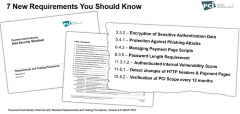

Payment Predictions: Preparing for 2025 Payment Trends
From stronger security standards to quickly changing customer behaviors and emerging technologies, businesses continue grappling with a changing payment landscape that presents unprecedented challenges. Trends established post-pandemic, like increasing fraud, changing regulations and evolving customer preferences, will continue to shape the payment landscape into 2025 and beyond.
Understanding these changes and defining the right strategies to handle them will be key to maintaining customer trust, consistent revenue and reducing fraud – a tall order for any business. In this article, we’ll explore the trends our experts at Payway believe will shape the payments industry in 2025 and what they mean for subscription-based companies.
PCI DSS v4.0 Phase 2 Will Take Effect in March
2024 was a big year for PCI DSS. Phase one of v4.0 of the payment card industry’s security standards took effect in March 2024, with the deadline for phase two compliance still looming in March 2025.
Phase one focused on foundational improvements like an inventory of all environments that store and process card data, fresh risk assessments aligned with the new regulations, stronger access security with more substantial password requirements and multi-factor authentication (MFA) for those accessing card data. Phase two builds upon this foundation with additional security measures, including:
- Enhanced network and application-level security, including strengthened firewall configurations, network segmentation to separate cardholder data from other environments and improved web application security with regular scans and updates
- Upgraded encryption protocols for data in transit and at rest, with an eye on future resilience to quantum-computing and encryption
- Enhanced logging systems to detect and respond to security incidents faster
For subscription-based businesses that must regularly access stored cardholder data, ensuring compliance with PCI DSS is essential. These regulations not only help maintain good standing with credit card companies but also provide customers with peace of mind, knowing their data is secure. One effective way to maintain compliance and reduce your overall scope is partnering with PCI DSS-certified third-party service providers like Payway. When your payment gateway utilizes advanced security measures and encryption while maintaining PCI DSS compliance, it significantly reduces your business’s risk related to sensitive cardholder data.
Safety and Security Will Become Top Concerns for Customers
In 2024, 82% of credit union members reported choosing payment methods based on security—a significant increase from 73% in 2023.[1] This rising concern reflects customers’ understanding of the frequency and sophistication of modern cybercrime and their desire to avoid becoming a victim.
By 2025, experts predict cybercrime will cost the global economy a shocking $10.5 trillion annually.[2]
Since more than 75% of card fraud incidents occur online, individuals and businesses alike are looking for ways to combat fraud and protect data. However, AI-powered fraud detection is helping companies fight back with tools to predict, detect and eliminate threats in real time. A leader in this realm, Mastercard, uses AI to scan 1 trillion data points in under a second, boosting their fraud detection rates by 20%.[3]
Additionally, card companies are launching new features to enhance identity verification with a myriad of technologies, including biometrics, machine learning and passkeys, to fortify their security and maintain their customers’ trust.
Credit Card Use Will Continue to Rise
In recent years, debit cards have eclipsed credit cards in popularity, but now, credit cards are back in the forefront. In 2024, 37% of shoppers reported preferring credit cards, narrowly surpassing the 35% who still favor debit transactions.[4]
Enticing rewards programs, enhanced security and other features are boosting credit card use and, in a notable shift, Gen Z has adopted them as their preferred payment method despite early hesitations about credit cards and debt. Additionally, more than half of people ages 18-43 have applied for a new credit card through their financial institution in the past year, showcasing rising demand among younger generations.[5]
Digital Wallets Will Become More Dominant
Enhanced security and ease continues to lure customers away from traditional, physical cards to digital wallets. Apple Pay, Google Pay and other mobile wallet providers are quickly becoming the preferred payment method for many customers.
However, there is a clear generational divide regarding mobile wallet adoption. 38% of Gen Z, 36% of younger millennials and 38% of older millennials report using mobile wallets a few times a week. In contrast, only 15% of Gen X and a mere 3% of baby boomers use mobile wallets that frequently.[6] With over 60% of the global population expected to use digital wallets by 2026, this gap could widen even further.
The convenience, speed and enhanced security of digital wallets are driving rapid adoption and will continue to do so well past 2025. Businesses that embrace this trend will not only streamline customer payments but also position themselves as forward-thinking and customer-focused.
AI Will Continue to Transform Fraud – and Fraud Detection
While all types of fraud are rising, first-party fraud is significantly increasing. This type of fraud occurs when a customer falsely disputes a charge with a merchant or bank, even though the product or service was delivered as expected. This issue has become increasingly significant in recent years. In 2024, 74% of customers reported disputing a charge within the past year, resulting in costly chargebacks for merchants.
2024 saw staggering increases in chargeback rates and values. Between the fourth quarter of 2023 and the first quarter of 2024, the average chargeback rate rose by 19% — partially due to holiday shopping. Specific industries have been hit especially hard, such as online travel and lodging, which leads the pack with an extraordinary increase of 816%, followed by eCommerce and digital goods and services, which saw rises of 222% and 59%, respectively. Additionally, the average chargeback value increased from $235.57 to $374.01 year over year, further compounding the impact.[7]
So what caused these increases? Economic stress has certainly intensified first-party fraud, which has been amplified further by social media content promoting “strategies” to save money by reclaiming funds illegitimately. Gen Z and millennials are the most likely to encounter this type of content, and 27% of consumers report seeing this type of content.
Young consumers are more likely to commit friendly fraud, with 42% of Gen Z admitting to engaging in it.[8]
Due to competing priorities, many businesses are leaving chargebacks undisputed. More than 40% of these chargebacks go unchallenged, while most businesses believe that at least 20% are due to friendly fraud.[9]
To overcome these issues, businesses are turning to advanced fraud prevention tools to identify and prevent suspicious activity. Payment gateways are incorporating fraud prevention measures into their solutions to identify unusual activity and alert businesses faster than ever.
Additionally, while AI has become a key tool for bad actors engaging in phishing and other types of fraud, it has also become one of the most potent weapons against the surge in friendly fraud. AI tools can:
- Monitor in real time to detect and respond to fraud as it happens
- Identify patterns and anomalies to uncover even complex fraud schemes
- Differentiate legitimate disputes from illegitimate chargebacks, helping businesses streamline the chargeback resolution process
- Automate investigations and evidence collection, saving time and resources
AI’s ability to learn and adapt as fraud schemes evolve will make it indispensable for safeguarding revenue and ensuring smooth, secure transactions.
Emerging Payment Trends Will Solidify
While credit cards take the lead and digital wallets become more popular, other payment options are also gaining traction.
Buy now, pay later (BNPL) services like Affirm, Afterpay and Klarna continue growing. With BNPL options, customers can enjoy extra flexibility while completing their purchases without relying on their credit cards.
Similar to BNPL features, customer payment recovery features are becoming more common. Since more than 50% of customers will abandon a purchase if they experience a payment failure, many are willing to use customer payment recovery features that allow customers to complete purchases despite initial payment failure and be charged later. Since these solutions work with any payment method, they help reduce business decline rates, reduce cart abandonment and boost customer satisfaction.
For subscription-based businesses, customer payment recovery is significant. A 5% increase in customer retention each month can lead to a 40% increase in subscriber base over 2 years.[10]
Cryptocurrency adoption is still in its early stages, but curiosity is growing, especially among younger generations. 45% of surveyed credit union members expressed interest in learning more about cryptocurrency and the options it provides from their financial institution.[1]
In the same vein as digital wallets, which allow users to access several payment methods through a single app, Visa found that more than half of card users want access to multiple accounts via a single credential. To meet this need, Visa launched Visa Flexible Credential, which allows cardholders to toggle between debit, credit, and rewards cards, among other programs. With the desire for these features and the prevalence of digital wallets, we anticipate more solutions that provide access to more payment options with more simplicity will emerge.
What’s Next?
While we anticipate that the trends established over the past two years will continue, the rapid advancement of technology means that new technologies—and the associated threats—could significantly alter the payment landscape. Just as AI has quickly transformed business operations since 2022, emerging technologies and innovative strategies will continue influencing commerce and the payment methods that facilitate daily business functions.
At Payway, we recognize businesses need to provide frictionless payment experiences. That’s why we actively monitor the evolving technology landscape and the emerging payment trends. Our gateway offers the payment options that customers desire, supported by advanced security measures and fraud detection features. Additionally, we provide streamlined administration and an architecture designed to minimize the burden of PCI DSS compliance for businesses. We remain dedicated to being the leading payment gateway for subscription-based companies and to continuously evolving our solutions to meet the changing needs of today’s consumers in 2025 and well into the future.


